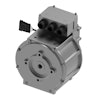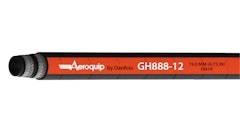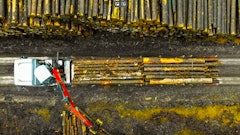Association of Equipment Manufacturers (AEM)
Dennis Slater, president
What legislation AEM is working on?
Right now the highway bill is a big issue. The last highway bill expired Sept. 30th. We’ve been working around the clock on our Start Us Up USA! campaign.
AEM and AED are doing this together. We’re trying to get people to understand that it’s a recession for the country, but in our industry it’s a depression. The auto industry has manufacturing jobs down 16%, construction is down 37%. As a market we’ve lost 550,000 jobs in construction. Our biggest problem is market uncertainty.
The key part of regulations is to look at what is really doable. I think industry really wants to cooperate with this. They do want cleaner air, they do want more efficient machines and safer machines.
Have you made progress on the Transportation Bill?
The biggest thing when talking to people was they hadn’t heard the message. They didn’t hear about all of the jobs that were lost. They didn’t hear that market uncertainty is going to create a problem. They thought they could extend their current bill 18 months and “kick the can down the street a little farther” and thought it’d be okay, but really it won’t.
I think they also understand the manufacturing base of their individual states is going to be hurt drastically by this.
What role will AEM play to assist in the forward progress of the industry?
Because of the way the economy has been, we look at the association and think “How can we help our members get business?” That’s really our vision of what the association should do.
One is public policy, where before we worked in a lot of coalitions and sort of behind the scenes getting things done. Now we’ve decided for the equipment side of this we need to get in front and be bold thinkers and take lead positions and represent our own views.
Another is our statistics program. They know what their market share is in the U.S., what is it in China, Russia, or Brazil? Right now we’re developing programs so they can figure out the world market. If you’re a manufacturer for a product and you only sell in the U.S., but you want to go to China which is a huge market, you want to know how many trenchers they even use over there. Or is trenchers even a market? Market identification and market share data.
When do you foresee the recovery?
Until you have some market certainty in the housing market and the credit issues get resolved there, I think it’s going to be very slow coming back on the housing side. Until you get the construction industry back involved with the highway bill, and get them employed again, it’s going to be hard for the economy to be strong.
However, I think the companies have reacted well. Their efficiencies are what are helping the bottom line now, not sales. Sooner or later, sales will come back, too.
Agriculture is fundamentally stronger. The world is getting bigger, there are more people to feed. Agriculture is well placed for that. On the energy side, everything is dipping their way with biofuels.
Mining long-term is always going to be a good market. As China’s economy gets going again, which it is, they’re going to have a high demand for product and they’re going to need steel and other resources to build those products.
AEM provides public policy (legislation to regulation that protects the market place or defends the points of views reflected in its industries); tradeshows; market data; and technical standards to its members.
» Read full interview with Dennis Slater, president.
National Fluid Power Association (NFPA)
Eric Lanke, executive director
How do members play an active role with NFPA?
An example that leaps to mind is NFPA’s market information services. Most companies contribute a few shipment and order numbers to our Confidential Shipment Statistics program each month and in exchange receive a wealth of information on the direction the fluid power industry is taking. And on top of the data, NFPA provides participants with an Electronic Statistical Toolkit that helps them create analysis tailored to their company. Our State of the Fluid Power survey is a quick, easy opinion survey that has been shown to be a leading indicator for our industry.
Another example is our research and education efforts. NFPA helped leverage member contributions in securing a National Science Foundation grant that launched the Center for Compact and Efficient Fluid Power. That’s thousands leveraged to secure millions. As technology continues to develop at the Center, the benefit in terms of new markets and applications for fluid power is potentially immeasurable, and includes a higher profile for fluid power that helps attract the best and brightest engineering talent to the industry.
We’re now looking to do something similar with the U.S. Department of Energy. We’re meeting with DOE officials who seem interested in funding additional research aimed at making fluid power more energy efficient.
What role will NFPA play to assist in the forward progress of your industry?
Our new Technology Roadmap for the Fluid Power Industry charts an innovation agenda of research objectives and strategies to bring about industry-elevating technology advancements for hydraulics and pneumatics. The team that developed it included representation from 19 of our members and was led by the National Center for Manufacturning Sciences.
The Roadmap will help our members meet the future needs of their customers; expand into new customer markets; and attract the best and brightest young engineers to their companies.
R&D and technology focuses?
1. Increasing the energy efficiency of fluid power components and systems.
2. Building “smart” fluid power components and systems (i.e., ones that perform self diagnostics/prognostics and troubleshooting; integrate easily with “plug and play” functionality).
Both are key to keeping fluid power competitive with alternate technologies. Given fluid power’s domination in terms of power density, significant gains in efficiency like those charted in the Roadmap will radically change the landscape of application for our technology. Similarly, truly “plug and play” fluid power components would shatter existing impressions of fluid power’s ease of use and adaptability.
NFPA is a member-driven organization. Association committees and boards take the lead in directing projects that strengthen the fluid power industry and provide members with tools for their own success.
» Read full interview with Eric Lanke, executive director.
Diesel Technology Forum (DTF)
Allen Schaeffer, executive director
How do members play an active role with DTF?
A number of ways, from providing input and direction on policy papers to participating in events with their people, technology or equipment.
We have a variety of member representatives involved in different aspects of our work, including professionals in marketing, communications, government affairs, engineering and other disciplines represented on various DTF committees and activities.
R&D and technology focuses?
Owing to the pressure on climate change policies and regulations, there is a lot of growing work in the integration of the vehicle and machine into its work environment and looking for efficiencies there. Research work continues to make further improvements to the overall thermal efficiency of diesel engines through things like the 21st Century Truck Partnership at DOE.
And we’re expecting the second wave of research information in the next 18 months on health and emissions profiles of clean diesel technology tested in 2007 engines.
One could speculate that every machine and vehicle will have some kind of hybrid component in the coming years to pick up incremental gains in efficiency. There is still a lot of discussion about the 2010 emissions milestone for heavy-duty highway vehicles and their emissions control technologies—particularly the introduction of SCR for on-highway and ultimately off-road applications.
There will be further work on optimizing this new technology solution in the years ahead. And there continues to be work on biofuels and second generation renewables; there will be pressure on seeing higher blends of biofuels in every kind of transportation fuel.
Future problems or hurdles?
Economic recovery and growth is front and center and drives everything, including equipment and vehicle sales, the ability to invest in new technology and deliver the clean air and climate benefits that everyone wants. Longer term recovery is going to have an impact on fleet replacements, repair and ownership costs.
There are probably some issues on the horizon dealing with the legal aspects of state diesel engine regulation, particularly whether states can require mandatory retrofitting or retirement of diesel engines and equipment.
There is pending litigation in California now by a number of groups. Outside of California, there are no state mandatory programs yet, but there are efforts to push those regulations throughout the U.S. These policies have direct and significant impacts on contractors, truckers and others in terms of compliance costs, and value of their capital rolling stock and assets.
Biodiesel and renewable diesel fuel are still areas of much interest and discussion, but the economy has slowed the rapid construction of biodiesel refineries, and the price of diesel is keeping people on the sidelines. Where there is continued use, there remain quality and consistency issues with the first generation products that concern many OEMs.
EPA’s renewable fuels proposals also seem to favor renewable diesel fuels from a variety of feedstocks processed differently as opposed to strictly fatty acid methyl ester (FAME) soy-based biodiesel which has life cycle cost and carbon economics that don’t look as good.
DTF represents companies that see value in promoting a greater understanding of the environmental, energy and climate benefits of diesel engines across all applications. It brings together engine and vehicle manufacturers, fuel refiners, suppliers and emissions control technology companies.
» Read full interview with Allen Schaeffler, executive director.
Farm Equipment Manufacturers Association (FEMA)
Robert K. Schnell, executive VP
Future hurdles for agriculture?
With so much land being converted from farmland to residential and environmental laws becoming much more restrictive, I see that much future agricultural growth will take place outside of the U.S. Already, that is happening in the livestock industry.
Why was agriculture able to withstand the economic downturn so well?
Agriculture has, no doubt, fared better through the recent economic downturn, although the recession is certainly beginning to be felt in this industry. The positive effects on agriculture have been relatively high commodity prices, a good export market, relatively low and stable interest rates and a healthy demand for ethanol. Negative factors now beginning to be felt are higher input prices and lower commodity prices, particularly in the dairy and livestock industries.
Farm Equipment Manufacturer’s Assn. (FEMA) provides a focus for marketing shortline equipment through networking, communications and technology.
» Read full interview with Robert K. Schnell, executive VP.
American Society of Agricultural and Biological Engineers (ASABE)
Ronald E. Yoder, president
What role will ASABE play to assist in the forward progress of your industry?
Because a large portion of our mission is to provide opportunities for exchange of ideas and new technologies, ASABE will continue to have a significant positive role in assisting the forward progress of the industries represented by our members.
ASABE also conducts outreach to agencies and organizations with allied interests and provides leadership in activities that support industry. In the area of international standards development, for example, ASABE serves as the U.S. Technical Advisory Group for several ISO technical committees. Participation in those activities keeps members informed and also advances their respective industries in the global marketplace.
R&D and technology focuses?
Based on the information that is being published in our technical journals and also in Resource, our Society magazine, nanotechnology, biofuels, environmental quality, and food safety are key issues. Other key issues are energy conservation and international standardization.
In the area of off-road machines, two areas of focus have emerged, 1) increased automation, and 2) improved efficiencies, especially in the use of fuels, and, we might add, in the use of alternative fuels.
Future problems or hurdles?
Some potential hurdles for our Society are demographics of our membership and how that will affect the level of volunteerism – we rely on the members to run the Society. Also, the current economy is putting pressure on membership dues income, as well as income for programs that benefit industry (standards, conferences, awards, scholarships). The increasingly rapid rate at which new technologies are being adopted presents a challenge to keep our members apprised of those changes and to continue to develop new and effective ways to communicate with our members.
In what ways does the AE50 award help advance machine technology?
The ASABE AE50 awards program recognizes outstanding innovations in new product development and widely publicizes the unique features of these products. By drawing attention to the significant improvements or new developments, the bar for innovation is set higher each year. The competition helps inspire engineers and others involved in new product development and provides a showcase for their accomplishments.
ASABE provides a forum to exchange ideas, learn about new technologies, and publish research results. ASABE advances the agricultural and biological engineering profession and provides opportunities for professional development. As a not-for-profit educational and scientific organization, we provide an unbiased, credible voice for government outreach and the development of consensus standards.
» Read full interview with Ronald E. Yoder, president.
National Biodiesel Board (NBB)
Steve Howell, technical director
Education programs?
We utilize the latest in technology developments to keep our members up to speed and involved in their trade association. We host regular conference calls, meetings and webinars; provide a wide range of regular communications in several formats; and coordinate the industry’s premier conference and expo.
What role will NBB play to assist in the forward progress of the biodiesel and off-road equipment industries?
NBB works cooperatively with OEMs on ASTM fuel standards, testing of biodiesel in new engine technologies, sharing information and data, and promoting ASTM quality through the industry’s BQ-9000 fuel quality program. NBB has a very active OEM outreach program to share data and the latest biodiesel information with the biodiesel departments at each company. NBB also has dealer and diesel technician training programs for those new to biodiesel. NBB’s efforts with OEMs has been instrumental in the fact that blends of B20 or higher are now accepted by more than 18 OEMs, compared to only two manufacturers supporting up to B5 at the start of the OEM Outreach Program in 2005.
In addition, the NBB’s education and outreach efforts have helped expand interest in biodiesel among fleet managers and equipment users. Customers interested in or required to reduce their carbon footprint are looking to biodiesel as a seamless and affordable option. Success stories from around the nation are helping to drive this interest and customers’ confidence in the renewable fuel.
Future hurdles?
The future looks very bright for the biodiesel industry. With the recent passage of ASTM standards for B6 to B20 blends, ASTM D7467, and the incorporation of up to 5% biodiesel as a fungible component into the conventional diesel fuel standard, ASTM D975, OEMs now have the standards with which to design all future diesel engines. Most OEMs have already incorporated B20 into their future design considerations. Ensuring that all new diesel engines support the use of B20 will be important moving forward.
NBB works to increase the demand of commercially produced biodiesel in the U.S. through education, communication and quality assurance programs, and by serving as the national coordinating entity and clearinghouse of information. NBB works with its members to eliminate barriers to sales, secure necessary product approvals, and quantify the benefits of biodiesel use to customers and society as a whole.
» Read full interview with Steve Howell, technical director.















